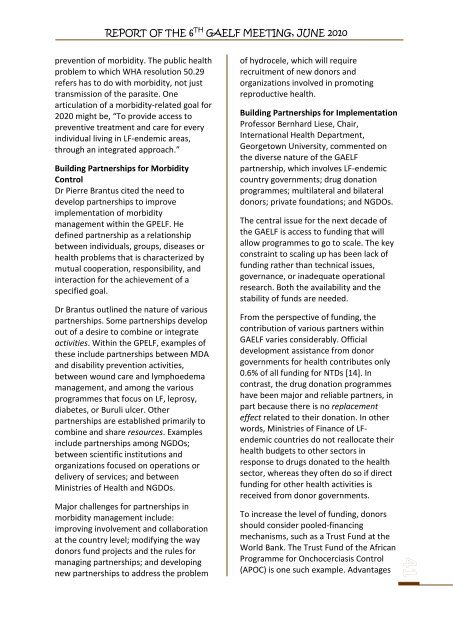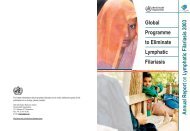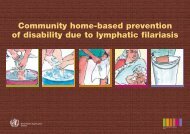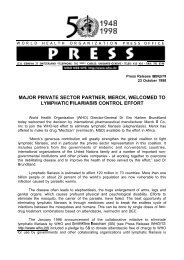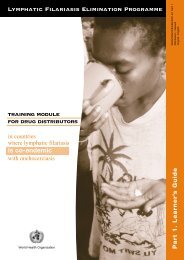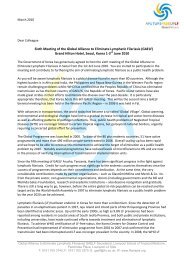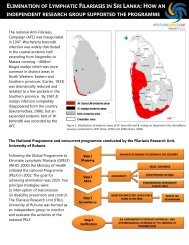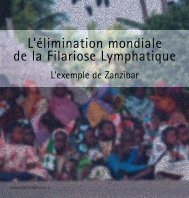English - Global Alliance to Eliminate Lymphatic Filariasis
English - Global Alliance to Eliminate Lymphatic Filariasis
English - Global Alliance to Eliminate Lymphatic Filariasis
You also want an ePaper? Increase the reach of your titles
YUMPU automatically turns print PDFs into web optimized ePapers that Google loves.
REPORT OF THE 6 TH GAELF MEETING, JUNE 2010<br />
prevention of morbidity. The public health<br />
problem <strong>to</strong> which WHA resolution 50.29<br />
refers has <strong>to</strong> do with morbidity, not just<br />
transmission of the parasite. One<br />
articulation of a morbidity-related goal for<br />
2020 might be, “To provide access <strong>to</strong><br />
preventive treatment and care for every<br />
individual living in LF-endemic areas,<br />
through an integrated approach.”<br />
Building Partnerships for Morbidity<br />
Control<br />
Dr Pierre Brantus cited the need <strong>to</strong><br />
develop partnerships <strong>to</strong> improve<br />
implementation of morbidity<br />
management within the GPELF. He<br />
defined partnership as a relationship<br />
between individuals, groups, diseases or<br />
health problems that is characterized by<br />
mutual cooperation, responsibility, and<br />
interaction for the achievement of a<br />
specified goal.<br />
Dr Brantus outlined the nature of various<br />
partnerships. Some partnerships develop<br />
out of a desire <strong>to</strong> combine or integrate<br />
activities. Within the GPELF, examples of<br />
these include partnerships between MDA<br />
and disability prevention activities,<br />
between wound care and lymphoedema<br />
management, and among the various<br />
programmes that focus on LF, leprosy,<br />
diabetes, or Buruli ulcer. Other<br />
partnerships are established primarily <strong>to</strong><br />
combine and share resources. Examples<br />
include partnerships among NGDOs;<br />
between scientific institutions and<br />
organizations focused on operations or<br />
delivery of services; and between<br />
Ministries of Health and NGDOs.<br />
Major challenges for partnerships in<br />
morbidity management include:<br />
improving involvement and collaboration<br />
at the country level; modifying the way<br />
donors fund projects and the rules for<br />
managing partnerships; and developing<br />
new partnerships <strong>to</strong> address the problem<br />
of hydrocele, which will require<br />
recruitment of new donors and<br />
organizations involved in promoting<br />
reproductive health.<br />
Building Partnerships for Implementation<br />
Professor Bernhard Liese, Chair,<br />
International Health Department,<br />
George<strong>to</strong>wn University, commented on<br />
the diverse nature of the GAELF<br />
partnership, which involves LF-endemic<br />
country governments; drug donation<br />
programmes; multilateral and bilateral<br />
donors; private foundations; and NGDOs.<br />
The central issue for the next decade of<br />
the GAELF is access <strong>to</strong> funding that will<br />
allow programmes <strong>to</strong> go <strong>to</strong> scale. The key<br />
constraint <strong>to</strong> scaling up has been lack of<br />
funding rather than technical issues,<br />
governance, or inadequate operational<br />
research. Both the availability and the<br />
stability of funds are needed.<br />
From the perspective of funding, the<br />
contribution of various partners within<br />
GAELF varies considerably. Official<br />
development assistance from donor<br />
governments for health contributes only<br />
0.6% of all funding for NTDs [14]. In<br />
contrast, the drug donation programmes<br />
have been major and reliable partners, in<br />
part because there is no replacement<br />
effect related <strong>to</strong> their donation. In other<br />
words, Ministries of Finance of LFendemic<br />
countries do not reallocate their<br />
health budgets <strong>to</strong> other sec<strong>to</strong>rs in<br />
response <strong>to</strong> drugs donated <strong>to</strong> the health<br />
sec<strong>to</strong>r, whereas they often do so if direct<br />
funding for other health activities is<br />
received from donor governments.<br />
To increase the level of funding, donors<br />
should consider pooled-financing<br />
mechanisms, such as a Trust Fund at the<br />
World Bank. The Trust Fund of the African<br />
Programme for Onchocerciasis Control<br />
(APOC) is one such example. Advantages<br />
41


